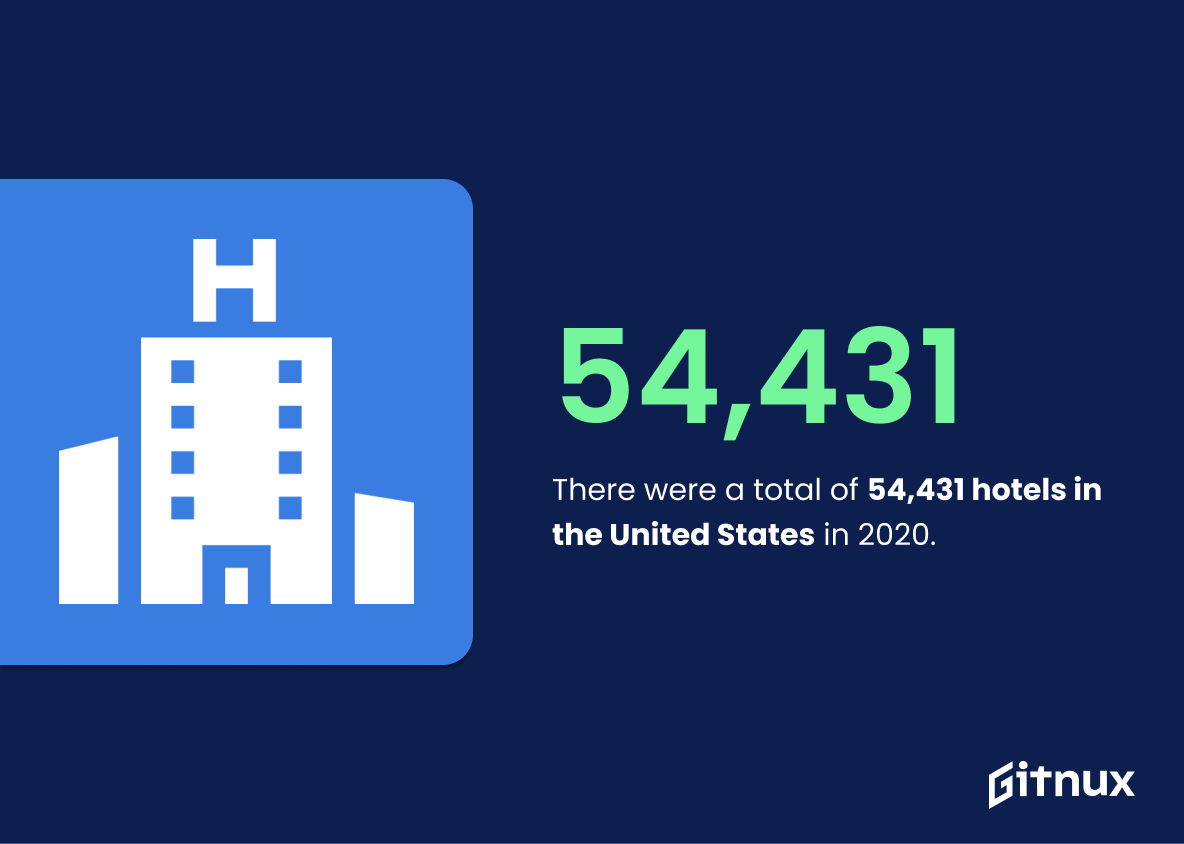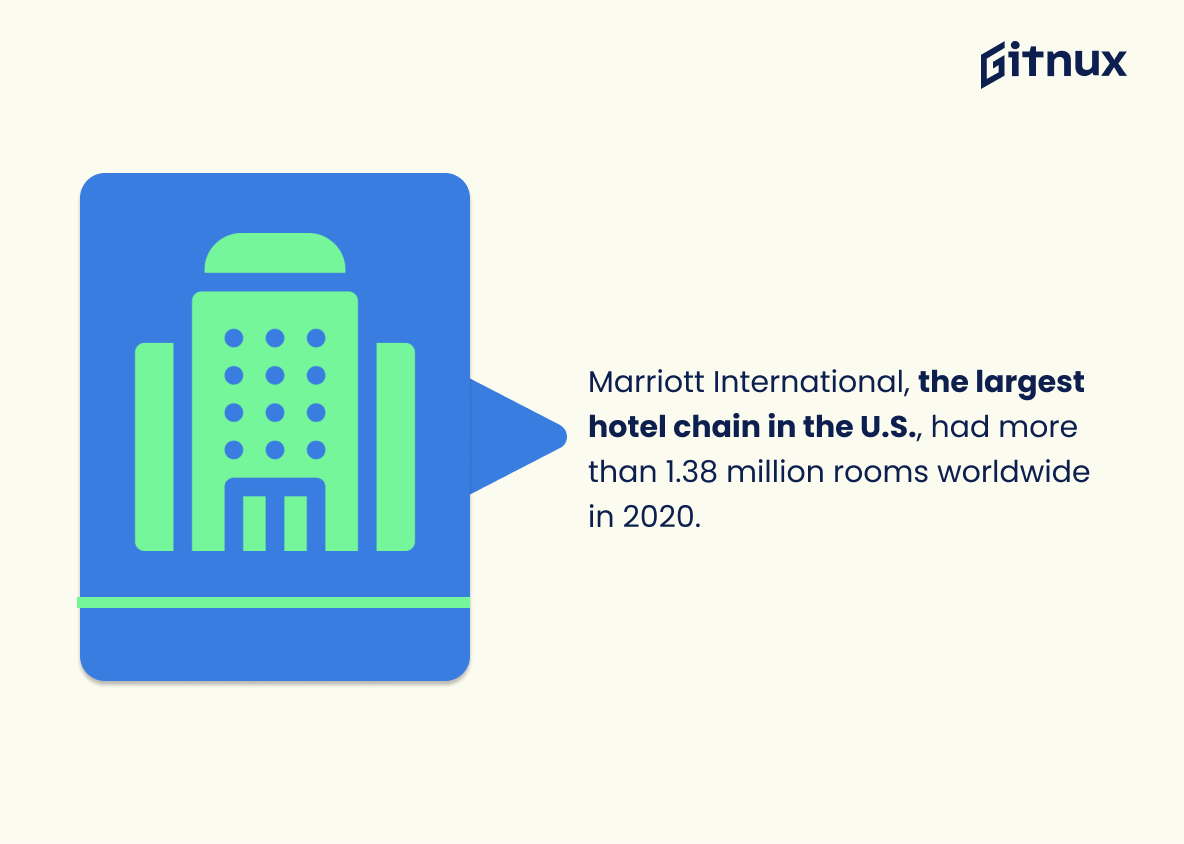The U.S. hotel industry has experienced a tumultuous year in 2020 due to the COVID-19 pandemic, with total revenue dropping to 84.6 billion dollars and occupancy rate falling to 44%. The average daily rate for 2021 is expected to be 111.38 U.S. dollars, while there were 54,431 hotels and more than 5 million rooms across the United States last year alone – both of which have seen significant declines since 2019 when leisure travel spending amounted to 194 billion dollars and asset management company SAGE Hospitality reported an occupancy rate of 74.5% for their 52 hotels nationwide respectively .
Marriott International had 1.38 million rooms worldwide in 2020 as luxury hotels saw an average occupancy rate of 25%, while 770 projects remained in the construction pipeline that same year despite suffering from a loss of over 100 billion dollars due mainly attributed by the pandemic outbreak itself; international guests spent 42 billion on retail items at U.S.-based establishments during 2019 whilst 282 thousand people were employed within hotel operations & management positions throughout 2021 so far – not forgetting that extended stay segment generated 15 point six (15) billions back then too. Smartphone usage amongst travelers was also high at 81 percent who used them search up information about accommodations prior booking one out themselves; resort fees averaged 13 US Dollars per night according tot he Deloitte report published late last year before concluding this overview with New York City’s own hospitality sector witnessing its own sharp decline from 93 point eight (93%) down fifteen point two (15%) between February & April 2020 respectively.
U.S. Hotel Industry Statistics Overview
There were a total of 54,431 hotels in the United States in 2020.
This statistic is a telling indication of the size and scope of the U.S. hotel industry. It speaks to the sheer number of hotels that are available to travelers, and the amount of competition that exists in the market. It also provides insight into the economic health of the industry, as well as the potential for growth. This statistic is an important piece of the puzzle when it comes to understanding the U.S. hotel industry.
The number of U.S. hotel rooms exceeded 5 million in 2020.
This statistic is a testament to the resilience of the U.S. hotel industry in the face of the pandemic. Despite the economic downturn, the number of hotel rooms in the U.S. has continued to grow, indicating that the industry is still thriving. This is an important statistic to consider when discussing the current state of the U.S. hotel industry.
In 2019, leisure travel spending in U.S. hotels amounted to 194 billion dollars.
This statistic is a testament to the immense success of the U.S. hotel industry in 2019. It shows that despite the economic downturn, people still chose to spend their money on leisure travel, indicating that the industry was able to remain resilient and profitable. This statistic is an important indicator of the health of the U.S. hotel industry and provides valuable insight into the industry’s performance.
Marriott International, the largest hotel chain in the U.S., had more than 1.38 million rooms worldwide in 2020.
This statistic is a testament to the sheer size and scope of Marriott International’s presence in the U.S. hotel industry. With over 1.38 million rooms worldwide, Marriott International is a major player in the industry, and its success is indicative of the overall health of the U.S. hotel industry. This statistic is a valuable insight into the current state of the industry and provides a useful benchmark for comparison with other hotel chains.
Luxury hotels in the United States had an average occupancy rate of 25.5% in April 2021.
This statistic is a telling indication of the current state of the U.S. hotel industry. It reveals that luxury hotels in the United States had a significantly lower occupancy rate in April 2021 compared to pre-pandemic levels, highlighting the impact of the pandemic on the industry. This statistic is an important piece of information for anyone looking to gain insight into the U.S. hotel industry and its current trends.
In 2020, there were 770 U.S. hotel projects in the construction pipeline.
This statistic is a telling indication of the current state of the U.S. hotel industry. It shows that despite the economic downturn caused by the pandemic, the industry is still seeing growth and investment in new projects. This is a positive sign for the industry and could be a sign of a recovery in the near future.
The COVID-19 pandemic led to a loss of more than 100 billion dollars in revenue in the U.S. hotel industry in 2020.
This statistic is a stark reminder of the devastating impact the COVID-19 pandemic has had on the U.S. hotel industry. It highlights the immense financial losses the industry has suffered, and serves as a warning of the potential long-term consequences of the pandemic. This statistic is an important piece of information to consider when discussing the current state of the U.S. hotel industry.
In 2019, total retail spending by international guests at U.S. hotels was approximately 42 billion U.S. dollars.
This statistic is a testament to the immense popularity of U.S. hotels among international guests. It highlights the fact that U.S. hotels are a major draw for travelers from around the world, and that they are willing to spend a significant amount of money to stay in them. This is an important indicator of the strength of the U.S. hotel industry, and it is a key statistic to consider when discussing the industry’s overall performance.
During 2021, an estimated 282.7 thousand people were employed in hotel operations and management positions in the United States.
This statistic is a telling indication of the size and scope of the hotel industry in the United States. It demonstrates that the industry is a major employer, providing jobs to hundreds of thousands of people. This statistic is also important in understanding the economic impact of the hotel industry, as it shows the number of people who are employed in the sector and the amount of money they are contributing to the economy.
The extended-stay segment of the U.S. hotel industry generated approximately 15.6 billion U.S. dollars in 2019.
This statistic is a testament to the success of the extended-stay segment of the U.S. hotel industry, demonstrating that it is a lucrative and profitable sector. It is an important indicator of the overall health of the industry, and provides insight into the current trends and developments in the industry. This information can be used to inform decisions about investments, marketing strategies, and other business decisions related to the U.S. hotel industry.
The pandemic outbreak had a notable impact on the New York City hotel occupancy rate, witnessing a sharp decline from 93.8% in February 2020 to 15.2% in April 2020.
This statistic is a stark reminder of the devastating effects of the pandemic on the U.S. hotel industry. It illustrates the dramatic drop in occupancy rates in New York City, one of the most popular tourist destinations in the country, in a matter of months. This serves as a powerful example of the economic impact of the pandemic on the hotel industry, and highlights the need for further support and assistance to help the industry recover.
U.S. hotel industry’s total employment was 1,677 in February 2020, witnessing a steep decline to 758 in May 2020 due to the COVID-19 pandemic.
This statistic is a stark reminder of the devastating impact the COVID-19 pandemic has had on the U.S. hotel industry. The drastic drop in employment from 1,677 to 758 in just three months is a clear indication of the economic hardship the industry has faced due to the pandemic. This statistic serves as a powerful reminder of the need for continued support for the hotel industry in order to ensure its survival.
In 2019, U.S. travelers paid an average of 13 U.S. dollars per night in hotel resort fees.
This statistic is a telling indication of the current state of the U.S. hotel industry. It reveals that travelers are paying an average of 13 U.S. dollars per night in resort fees, which is a significant amount of money for a single night’s stay. This statistic is important to consider when discussing the U.S. hotel industry, as it provides insight into the cost of staying in a hotel and the potential profitability of the industry.
In 2019, 81.3% of U.S. hotel guests used their smartphones to search for hotel information.
This statistic is a telling indication of the importance of mobile technology in the U.S. hotel industry. It shows that the majority of hotel guests are relying on their smartphones to search for hotel information, which means that hotels need to ensure that their websites and other digital platforms are optimized for mobile use. This statistic is an important reminder for hotels to stay up-to-date with the latest mobile technology trends in order to remain competitive in the industry.
Conclusion
The U.S. hotel industry has experienced a significant decline in revenue and occupancy rate due to the COVID-19 pandemic, with total revenue dropping to 84.6 billion dollars in 2020 compared to 208.19 billion dollars in 2019 and an average occupancy rate of 44% for 2020 versus 74.5% for SAGE Hospitality’s 52 hotels alone in 2019. Despite this downturn, there were still 54,431 hotels across the United States as of 2020 with more than 5 million rooms available and 770 projects currently under construction or planned for 2021; leisure travel spending also amounted to 194 billion dollars that same year while international guests spent 42 billion on retail items at U.S hotels during 2019 – all signs pointing towards a potential recovery from these unprecedented losses over time if current trends continue into 2022 and beyond.. The luxury segment is already showing promise with an April 2021 average occupancy rate of 25%, indicating that travelers are beginning to return despite lingering concerns about safety protocols related to the virus outbreak itself – though it remains unclear how long it will take before pre-pandemic levels can be achieved again given ongoing economic uncertainty worldwide
References
0. – https://www.statista.com
1. – https://www.aytm.com
2. – https://www.ahla.com
3. – https://www.bls.gov
4. – https://www..deloitte.com















